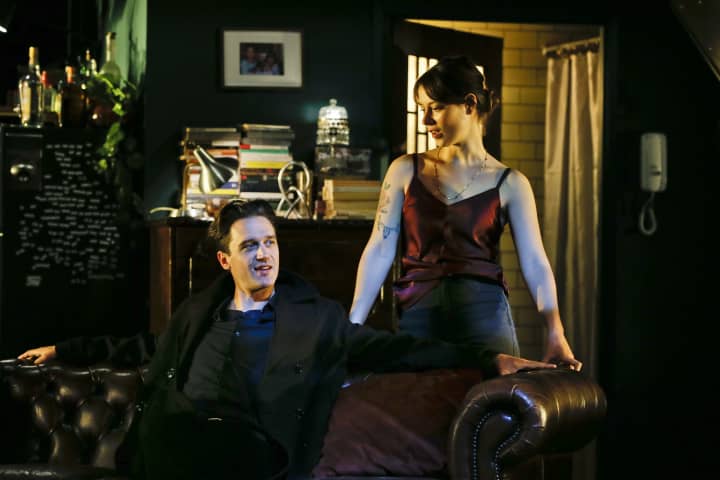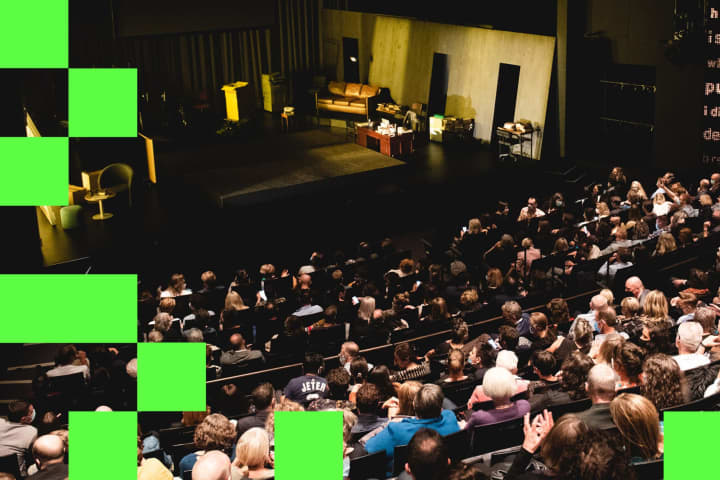A former dancer, Xanthe Beesley was in her early 20s when she had what she calls a lightbulb moment during which she realised she could marry her passion for movement with her love of theatre, to find ways ‘to blend both worlds’. Today, as a physical dramaturgist, she is ‘looking for ways to bring movement and really embodied performance into any sort of theatrical process.’
The idea of ‘physical dramaturgy’ might not be all that familiar. It is, Beesley explains, the ‘idea of attending to the physical life of a work. It’s about supporting the director and the actors to create this world that feels embodied and where all of the elements of production work together to make meaning and to support the storytelling.’
Fighting, moving and intimacy
The physical dramaturgy work Beesley does as a movement director is distinct from choreography, although there can be some crossover. ‘I think there are two quite distinct skill sets,’ Beesley says. ‘But that doesn’t mean that one can’t do the other, or vice versa. For my approach, my dance background feeds into what I do, so if there are moments of choreography in a piece that’s a territory I can go into. But for me, the emphasis is primarily around working with actors, supporting the vision of the director and attending to the physical life of the play to ensure all of those pieces of the puzzle are working seamlessly together.’
‘There’s a safety element to it ... but there’s also the poetic aspects of how the movement feeds into a work.’
The world of physical dramaturgy and movement direction can also share space with fight choreography and intimacy coordination. It’s a space where things are somewhat interchangeable, Beesley says, ‘where the thing that we’re all looking at is how the body reads in space. There’s a safety element to it, around the actors being able to perform an action in a really safe way. But there’s also the poetic aspects of how the movement feeds into a work.’
From her perspective, Beesley’s focus is on taking ‘a really broad and holistic view of how a work operates’. This might mean attending to everything from actor movement to staging or composition of images, and how all these elements ‘read’ to an audience – including ‘the meaning of how and why an actor might engage with the space’ or an element in it. If there’s a fight movement in the performance, for instance, a fight coordinator will attend to the planning and choreography of those movements, with a special focus on their safety; Beesley, meanwhile, would attend to those elements ‘to ensure that they make sense, they don’t disrupt the flow of a work, they blend in with the overall formal style’.
As for intimate moments, Beesley sees her role as being about ensuring the action is ‘authentic and grounded’ whilst also being safe for the actors to perform. ‘We pay really careful attention to these moments that are crafted with the intimacy coordinator and then everything is broken down to make it quite technical. So I guess our work, as a team, is to consider how those elements are pieced back together so that it feels completely seamless in the performing of the work.’

Izabella Yena and Dan Spielman onstage in Sexual Misconduct of the Middle Classes. Photo: Jeff Busby
A movement vocabulary
Beesley talks about the importance of working with actors to developing a movement language, or a movement vocabulary, for each show. In trying to envision this concept, I’m reminded of a quote about The West Wing actor Richard Schiff: ‘his whole body is his face’. Beesley concurs: ‘Yeah! He has really extraordinary gestural work that he does as well; his gestures can read really loudly.’
It’s this kind of ‘embodied performance’ that Beesley aims to create, and having a movement vocabulary is an important part of the process. ‘I’m really interested in the idea of a movement vocabulary for a work, and that each work has its own distinct vocabulary because each work is an entirely new idea; each actor in any particular production will bring their own bodies, their own interests and their own physical way of being in the space, and then a director has their own vision. All of those things go into the mix to create a movement language for an individual show.’
‘I think it’s a brave way to work because you’re not necessarily coming into the room with all the answers – you’re allowing things to evolve in that space with that group of people at that time.’
This can involve ‘looking at the way space is used and talked about, and the actions that can be referenced within a movement style. And that style doesn’t have to be really bold or obvious; it can be quite subtle or quite nuanced.’
A working relationship
Beesley was the Union House Theatre co-artistic director with current MTC Associate Director Petra Kalive over two years. Their close working relationship – on the stage and running a company – let them develop a shorthand. ‘We have shared sensibilities around the type of work we enjoy and around ways of working. She has a real affinity with movement in her process.’
It was for this reason that Kalive brought Beesley in early during the rehearsal process for Sexual Misconduct of the Middle Classes, to support the work of the actors and to develop a movement vocabulary for the show. ‘With a work like this, which is thematically very serious, there might be a tendency to replicate that seriousness within the process,’ she says. ‘But Petra knew that she wanted to use theatre-devising approaches and more abstract ways of engaging with movement to open up the material, and to arrive at solutions on the floor in an organic way. I think that ease of movement can be really liberating in the way that it helps to approach text from more abstract angles.’

Izabella Yena and Dan Spielman rehearse Sexual Misconduct of the Middle Classes. Photo: Jacinta Keefe
She adds that she thinks this approach ‘can help the actors to tap into an emotional terrain in a way that that is safe and offers up surprises. It might be that you’re working in a way you haven’t practiced before or that you are thrown a way of playing on the floor that’s really different to anything that you’ve experienced, and how does that open up new ideas?’
This work can, in a sense, hotwire creativity. But part of this process can also involve stillness. As Beesley explains, there are stages in the process ‘where Petra might sit back and observe, and that will allow her to see small moments of play which might be the key to unlocking images or relationships or possibilities. So it’s also about how it can stimulate her thinking as a director. I think that’s really bold and exciting; I think it’s a brave way to work because you’re not necessarily coming into the room with all the answers – you’re allowing things to evolve in that space with that group of people at that time.’
Movement and Conduct of the Middle Classes
Asked why movement is so important for a work like Sexual Misconduct of the Middle Classes, Beesley suggests the answer is twofold. On the one hand, she says, it’s about allowing the team to explore things in the rehearsal room in a more playful way. ‘And it also allows us to explore in more abstract ways the dynamic between the two characters.’ On a more dramatic level, however, she views this work as being about human communication. ‘And communication is about what’s said, but equally about what is not said between people. I love this piece for its silences and what they mean, and for the loaded moments and the static moments and the muddiness, and the exploration of communication,miscommunication and misinterpreted communication. I think the movement provides a key tool for exploring that journey.’
For Beesley, Sexual Misconduct of the Middle Classes is ‘really beautifully written and really clever. Its seriousness and the importance of what it’s talking about is also balanced by a little bit of humour.’ But most importantly, she believes it’s a work that should encourage a conversation. ‘I hope it leads audiences to think a bit differently about the power dynamics that operate in familiar spaces. It’s as simple and as complex as that.’

Izabella Yena and Dan Spielman on stage. Photo: Jeff Busby
Sexual Misconduct of the Middle Classes is on in The Sumner Theatre. Tickets are available now.
Published on 15 March 2021





